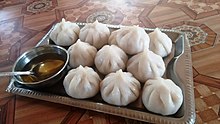Modaka
Modaka is a dumpling that is particularly popular in West and South India. The dough consists of rice or wheat flour and is filled with desiccated coconut and jaggery , also with chopped nuts (often cashews), sometimes khoa (also khoya ) and cardamom powder. Modern versions include ingredients like chocolate, mango, almonds, panir , tomatoes, and dates. Modakas can be steamed or deep-fried and served with ghee (clarified butter).
With a mention in the medical compendium of Sushruta , this sweet can be safely proven since about 870 AD. A mention of mōdagam in the Old Tamil poem Maduraikkanchi makes its existence likely as early as the 5th century. The Encyclopedia Manasollasa from around 1230 mentions a special kind of it called "Hagelkornkugel" ( Sanskrit वर्षोपलगेलक IAST varṣopalagolaka ) made of rice flour, sugar, and spices such as cardamom and camphor. However, the medieval Sanskrit texts do not exactly differentiate between Modaka and Laddu, an equally spherical dessert made from sesame or chickpea flour.
A related candy of the fig-shaped Modakas is the sickle-shaped karanji .
Tradition and legend
Modakas are the favorite food of the elephant-headed Hindu deity Ganesha , who is often depicted with a modaka in one of his four hands. One of his nicknames is therefore modakapriya and means "someone who loves modakas". The Ganesh Chaturthi festival in honor of Ganesh always ends with offering 21 Modakas to the image of the deity. After the ceremony, modakas are distributed to the believers.
However, the distinction between Modaka and Laddu is not always strict even today. The website of the Bombay Ganesh Temple Siddhivinayak , which is widely visited by Bollywood celebrities, describes his ganeshidol as having a Modaka in hand [1] , but laddus are distributed as prasad (food blessed by God). [2]
The Modaka is compared to the moon, with its segments representing the phases of the moon. Ganesha, who likes to eat a lot of sweets, is said to have once cursed the moon for making fun of it. Since then the moon has been growing and disappearing, regularly losing its beauty and sometimes disappearing entirely.
With esoteric Buddhism , Ganesha worship reached Japan in the 9th century, where Ganesha is invoked under the name Kangiten . In Japan, too, kangites very similar to Modaka are offered sweets called 唐 菓子 ( tōgashi , literally "Chinese confectionery") or 唐 果物 ( Karakudamono , literally "China fruit"), which were already mentioned in the novel Genji monogatari (around 1000 AD. ) occurrence. The entry “modaka” can be found in a Japanese dictionary from the same period.
Karanji - a sweet made specifically on Ganesh days from khoya, gulkand (rose petals), sugar, coconut, oil and suji (semolina).
Individual evidence
- ↑ KT Achaya: The Illustrated foods or India A-Z , New Delhi include: Oxford, 2009, p 173rd
- ↑ Victor Agostini, "Quelques notes sur le gâteau de Gaṇeśa", in: Flora Blanchon (ed.): Asie: Savourer, goûter , Paris: Presses de l'Université de Paris-Sorbonne, Paris 1995, pp. 63–72: P. 63.
- ↑ KT Achaya: The Illustrated foods or India A-Z , New Delhi include: Oxford, 2009, p 173rd
- ↑ a b The Oxford Companion to Sugar and Sweets . Oxford University Press, 2015, ISBN 978-0-19-931362-4 ( google.de [accessed July 15, 2020]).
- ↑ Ibid.





